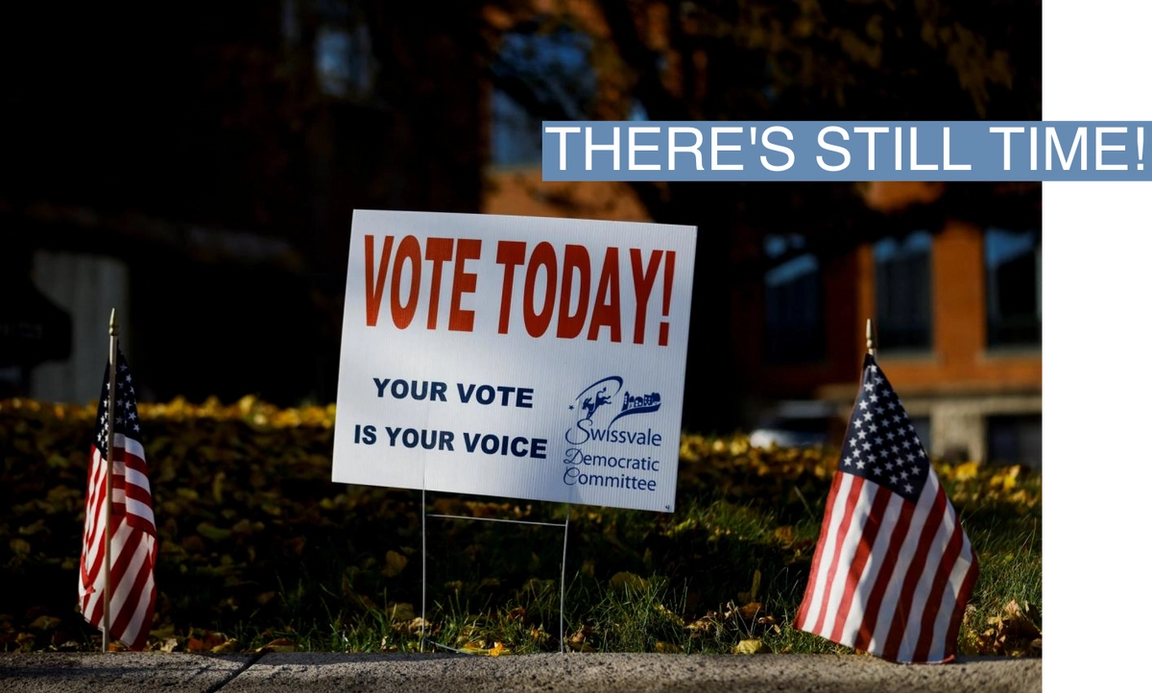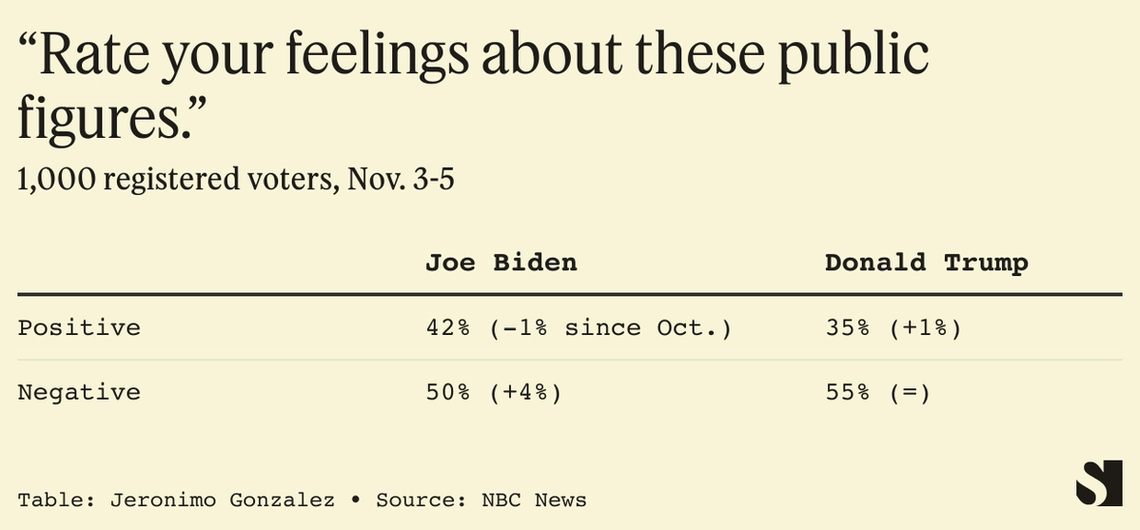 REUTERS/Quinn Gablicki REUTERS/Quinn GablickiTHE NEWS Republicans started preparing for midterm wins as soon as the votes were counted two years ago. Every factor — redistricting, narrow Democratic majorities in the House and Senate, the usual first-term presidential slump — would cut their way, they thought. Popular presidents could defy those trends. The first serious inflation spike in 40 years ensured that Joe Biden wouldn’t be popular. But the votes aren’t in yet, and there are plenty of hot takes that need to be tested with actual results. What will we learn about the country tonight, and when? Here’s a quick guide. Can Democrats beat history? Polls are at least a little closer than the vibes would indicate and Democrats are still hoping some combination of unique factors — an unpopular defeated president hanging around, a backlash to a 6-3 conservative court — help them beat the fundamentals. What would it look like if Democrats defied a “red wave?” We should know that early tonight. Polls begin closing in New Hampshire at 7 p.m. ET, where Trump-aligned GOP candidates for U.S. Senate and both House districts defied party leaders and won their nominations. If Democrats have made these races a referendum on MAGA candidates, we’ll see them hit their 2020 margins in liberal seacoast towns and hold their own in Republican towns where Trump under-performed other Republican nominees. The first adjusted exit polls will also tell us how the two parties’ electorates shifted, and whether Republicans gained as much as they needed to. In 2020, 38% of voters identified as “moderates,” a group that broke for President Joe Biden by 30 points. Biden won just 41% of the white vote, prevailing with support from 87% of Black voters, 65% of Latinos, and 61% of Asians. Did Republicans break through with Latino voters? Republicans recruited strong candidates in majority-Latino districts and poured millions of dollars into voter outreach. Spanish-language ads warned Latino voters that Democrats were ramping up inflation, opening the U.S.-Mexico border, and demolishing traditional gender roles for children. South Florida’s 7 p.m. ET poll closings will shape a lot of media reaction here, especially the results in Miami-Dade County, where 69% of residents are Latino and Gov. Ron DeSantis is favored to win after losing the 2018 race there by 20 points. President Biden won Florida’s Latino voters by just 7 points, according to the 2020 exit poll. The race between Democratic Rep. Abigail Spanberger and GOP county supervisor Yesli Vega will give Republicans their first chance on Tuesday to elect a Latina to Congress; Vega’s Prince William County, partially contained in the district, is one-quarter Latino. Biden won Latino voters in Virginia by 25 points, and last year, gubernatorial candidate Terry McAuliffe did even better in a losing effort despite lower Latino turnout. We’ll learn more when polls close in most of Texas at 8 p.m. ET. Republicans entered the final weekend bullish on winning not just the 15th Congressional District, which Biden lost by 2.9 points, but the 28th district (Biden won it by 7) and the 34th district (Biden by 15.5). That would require a collapse in Latino votes for Latino candidates who distanced themselves from the party’s left – exactly what every strategist recommended. The question across the southwest is whether Latinos with roots in Central America and the Philippines are drifting right. What was the Dobbs effect? There was an easy answer to that question this summer: Anger at the Supreme Court’s conservatives was motivating moderates, mostly women, who supported abortion rights. Higher Democratic turnout in August special elections helped the party hold on to a swingy House seat in New York and flip back Alaska’s at-large district, which they last won when Richard Nixon was president. More women joined the voter rolls, boosting Democrats after a year of Republican registration gains. Some of the movement showed up in early voting. Women had a 14-point turnout advantage in Michigan’s pre-election day vote, where Democrats hope that a ballot measure legalizing abortion in the state constitution will help them everywhere. We won’t know if that’s true until in-person voting is finished, and Republicans are far more likely to turn out on election day (Absentee ballot requests in Michigan skewed Democratic). In Michigan and Kentucky, if statewide abortion measures motivate conservatives, we’ll see it with higher turnout in rural, churchier areas. If the abortion issue has prevented some potential swing voters from going Republican, or not bothering to turn in ballots, we should see that in the states with the most college-educated white voters, like Colorado and Washington – places where the GOP has invested in Senate candidates who moderated their abortion views, but where Democrats warn that Republican majorities would pass abortion bans anyway. Did Democrats lose on crime? The GOP’s New York surge only happened recently, as donors to super PACs started to think that Rep. Lee Zeldin had a chance to unseat Democratic Gov. Kathy Hochul. But the party’s crime-focused script was written in last year’s elections, when Democrats melted down in Long Island and the GOP’s mayoral candidate, Curtis Sliwa, in New York outperformed expectations in non-white parts of the outer boroughs. Those same kinds of areas will tell us if voters who reliably voted Democratic during the Obama and Trump years are receptive to the GOP’s pitch on crime. Four years ago, then-New York Gov. Andrew Cuomo won re-election statewide by 1.43 million votes and got a 1.39-million vote cushion out of the city. What does Hochul get? Republicans tied Democrats to crime rates basically everywhere, but the movement in places where crime increased the most after 2020 – places where media coverage of that crime was relentless – will tell us the most about the politics of the issue. In Minnesota, Republicans are trying to unseat Attorney Gen. Keith Ellison, whose 2018 challenger lost by nearly 287,000 votes in Hennepin and Ramsey counties, covering the Twin Cities. In New Mexico, Gov. Michelle Lujan Grisham carried Albuquerque’s Bernalillo County by more than 58,000 votes the same year. We’ll see if anything has changed in either of those places after high-profile crime increases and millions of dollars blaming it on incumbent Democrats. There are more statewide races where the Republican crime attack was constant, especially in Wisconsin. To win his 2018 race, Wisconsin Gov. Tony Evers improved on recent Democratic candidates in suburban Milwaukee, winning the county itself and the conservative surrounding WOW counties (Waukesha, Ozaukee, Washington) by around 18,000 votes. In Pennsylvania, U.S. Senate nominee John Fetterman can’t lose too much support in and around Philadelphia, where he’s faced ads blaming criminal justice reform for an increase in murders. In Oregon, suburban Clackamas County backed Biden by 11 points, but that’s now ground zero for Republicans blaming Democratic drug and crime policies for addiction and homelessness. Where did MAGA candidates win and lose? Donald Trump will take credit for GOP wins and blame somebody else when they lose. Great, got that covered. But which races would lead to post-election arguments about whether Trump cost Republican votes? Trump got Mehmet Oz through his primary in Pennsylvania. He endorsed Blake Masters in Arizona after the first-time candidate blamed a rival, the state’s outgoing attorney general, for not doing more to prevent Joe Biden’s win from being certified. In Georgia’s Senate race, Republicans have complained all year about Herschel Walker getting Trump’s support even after they warned about the scandals that, on cue, blew up and caused Walker some problems. Every one of those candidates who wins will add to the Trump mythos; every one that loses will fuel questions about his political impact. If several blow it in winnable races, Republicans seeking to defeat Trump in the 2024 primaries could cite the losses as evidence they need to play it safe by nominating someone without his baggage. Similarly, Democrats might conclude that a Trump-led party, which they’re expecting to face in 2024, is still weak and that better economic conditions would make Biden a favorite to win re-election. Democrats have plenty on the line, too. If they don’t sweep the races where their own party organizations helped nominate pro-Trump and election conspiracy theorist candidates – Michigan’s 3rd district, the Senate race in New Hampshire – there will be recriminations and panic. And where will candidates who’ve run on election denial decide not to concede? A big enough GOP wave would make the question moot. But it’s most likely to happen in the states where Republicans anticipate long vote counts with Democrats holding the advantage in late-counted mail ballots, like Pennsylvania and Michigan, a dynamic that helped fuel conspiracy theories in 2020. DAVE’S VIEW This isn’t shaping up like the 2014 midterm, when Democratic turnout collapsed. It’s looking more like the 2021 elections in Virginia, when Democrats had the resources to turn out every base and persuadable voter, but Republicans swayed back some swing voters and got a historically large share of their presidential electorate – voters who typically only vote every four years – to turn out as well. My own guesses for tonight are directionally similar to conservative elections expert Henry Olsen’s, with Democrats perhaps holding on to a few more races but Republicans securing the Senate and a House majority of at least 235 seats. ROOM FOR DISAGREEMENT The early vote —which tends to favor Democrats since Trump made it a partisan issue in 2020 — has hit 45 million, surpassing the rate of even the 2018 midterms, which featured century-high turnout. Democratic strategist Simon Rosenberg argues that Republicans still have to prove their voters can show up on Election Day in similar numbers, especially after Democrats performed well in special elections over the summer. “If Rs are not at the upper end of their turnout models everywhere they are in trouble,” he tweeted on Tuesday. | 





